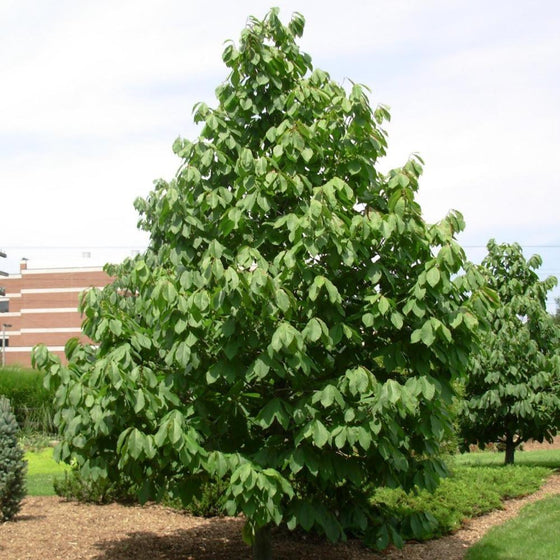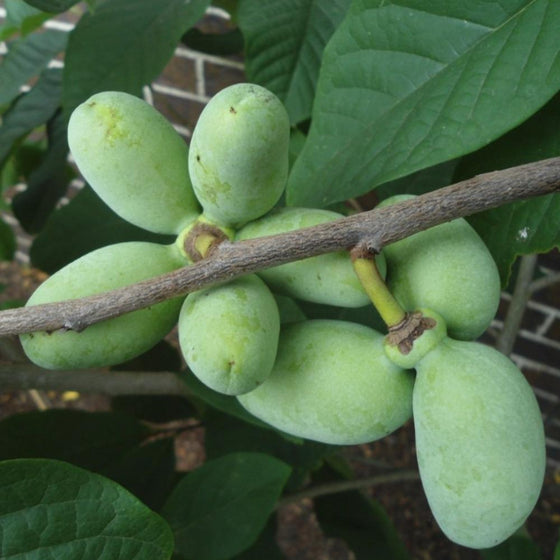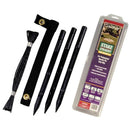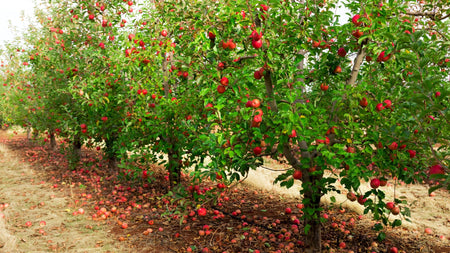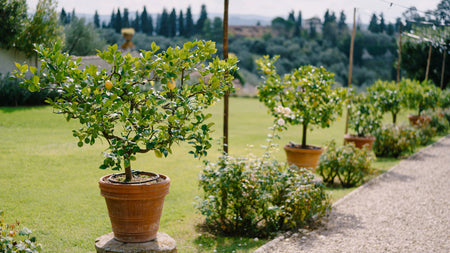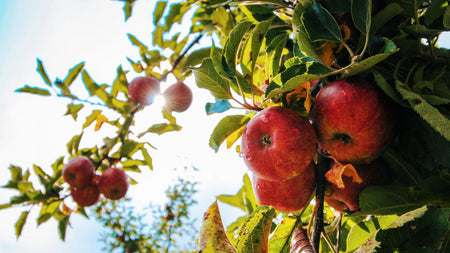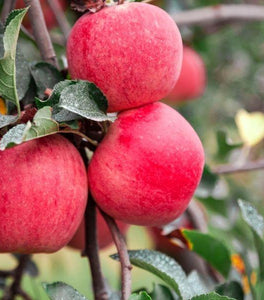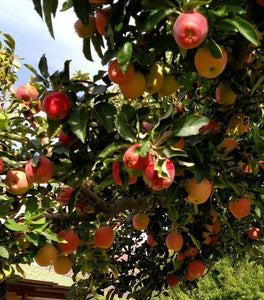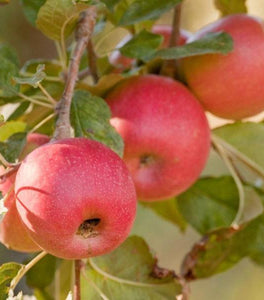
Images Depict Mature Plants
Paw Paw Trees - Asimina Triloba
Pawpaw Trees (Asimina triloba) are a hidden gem among native North American fruit trees, prized for their large, tropical-flavored fruit and adaptability to a variety of landscapes. Often called the "custard apple" due to their creamy texture and sweet, banana-mango flavor, pawpaws produce delicious, nutritious fruit that ripens in late summer to early fall. These small, deciduous trees typically reach 15 to 25 feet in height and are perfect for edible landscapes, backyard orchards, and native plant gardens. In addition to their fruit, Pawpaw Trees offer ornamental value with lush, tropical-looking leaves that turn bright yellow in the fall.
Thriving best in full sun to partial shade, Pawpaw Trees prefer rich, well-drained soils with consistent moisture, especially during the first few years of establishment. They are hardy in USDA zones 5 through 9 and can tolerate both cold winters and hot summers once mature. For successful fruit production, it’s recommended to plant two different pawpaw varieties to ensure cross-pollination. Besides their tasty fruit, Pawpaw Trees attract beneficial pollinators and provide a natural, low-maintenance addition to native gardens or wildlife-friendly landscapes.
Perfect for gardeners looking to grow unique and sustainable crops, Pawpaw Trees bring a taste of the tropics to temperate climates without requiring extensive care. Their lush foliage, compact size, and exceptional fruit make them a standout addition to home gardens, edible landscapes, and reforestation projects. Whether you’re planting for beauty, harvest, or habitat, Pawpaw Trees deliver four-season interest, environmental benefits, and a delicious reward, making them a must-have for anyone seeking a native fruit tree with remarkable flavor and charm.

| Hardiness Zone: | 6-11 |
|---|---|
| Mature Height: | 15 to 25 Feet |
| Mature Width: | 15 to 20 Feet |
| Classification: | Fruit tree |
| Sunlight: | Full sun to partial shade |
| Habit: | Upright |
| Foliage: | Green to purple |
| Soil Condition: | Any well drained soil; loamy |
| Water Requirements: | Water well until established |
How to Care for Pawpaw Tree
Before you buy a PawPaw Tree, make sure to read about the care instructions that are required and recommended to keep this plant healthy and flourishing.
How do I plant a PawPaw Tree?
To plant a Pawpaw Tree successfully, choose a location with full sun to partial shade and rich, well-drained soil that stays consistently moist, especially during the early years of growth. Pawpaws naturally grow in the understory of forests, so they tolerate partial shade well when young but produce the most fruit when given plenty of sunlight at maturity. Dig a hole twice as wide and just as deep as the tree’s root ball, ensuring the crown of the tree sits at or slightly above ground level to promote healthy drainage. Gently loosen any circling roots, place the tree carefully in the hole, and backfill with a mix of native soil and compost to enrich the planting site. Water deeply after planting to settle the soil around the roots. After planting your Pawpaw Tree, apply a 2–3 inch layer of organic mulch, such as shredded bark or leaf mold, around the base to retain moisture, regulate soil temperature, and suppress weeds. Keep the mulch a few inches away from the trunk to prevent rot. Because Pawpaw Trees have a deep taproot and fragile young roots, it’s important to minimize transplant shock by watering consistently during the first two years. For successful fruit production, plant at least two genetically different pawpaw varieties within 15–25 feet of each other to encourage cross-pollination. With the right care and planting conditions, your Pawpaw Trees will thrive, offering lush foliage, beautiful flowers, and a delicious tropical-style harvest in late summer to early fall.
How do I water My PawPaw Tree?
Watering your Pawpaw Tree correctly is essential, especially during the first few years, to establish a strong, healthy root system and ensure vigorous growth. Pawpaw Trees prefer consistently moist but well-drained soil, so it's important to water deeply and thoroughly, allowing the moisture to reach the tree’s developing taproot. During the first growing season, water your Pawpaw Tree two to three times per week, depending on rainfall, to maintain evenly moist soil without letting it become soggy. Using a soaker hose or drip irrigation system is ideal, as it delivers slow, deep watering that encourages healthy root development while minimizing evaporation. Once established, Pawpaw Trees become moderately drought-tolerant but will still benefit from supplemental watering during extended dry spells, especially in hot summer months. Check the soil moisture regularly—if the top 2–3 inches feel dry, it's time to water thoroughly. Applying a 2–3 inch layer of organic mulch around the base of the tree will help retain soil moisture, regulate root temperature, and reduce watering frequency. Proper watering will not only support lush, tropical-looking foliage but also help ensure strong flower and fruit development, allowing your Pawpaw Tree to produce delicious, tropical-flavored fruit year after year.
How do I fertilize My PawPaw Tree?
Fertilizing your Pawpaw Tree properly is important for promoting strong growth, vibrant foliage, and a healthy fruit set. In early spring, just before new growth begins, apply a balanced, slow-release fertilizer such as a 10-10-10 or 14-14-14 formula. Spread the fertilizer evenly around the drip line of the tree, taking care to keep it several inches away from the trunk to avoid burning the roots. After application, water thoroughly to help the nutrients penetrate the soil and reach the root system. Avoid over-fertilizing, especially with high-nitrogen fertilizers, as this can lead to excessive leafy growth at the expense of flower and fruit production. For continued soil health and slow, natural feeding, supplement with organic compost or well-aged manure once or twice a year. Pawpaw Trees thrive in slightly acidic to neutral soil, so maintaining good soil structure and nutrient balance is key to their long-term success. In nutrient-poor soils or for container-grown trees, a light second application of fertilizer in mid-summer can encourage continued healthy growth. With consistent, moderate fertilization, your Pawpaw Tree will reward you with lush tropical foliage, fragrant spring flowers, and a bountiful harvest of delicious, creamy, tropical-flavored fruit each year.

How and When do I Prune My PawPaw Tree?
Pruning your Pawpaw Tree should be done thoughtfully to promote a strong, healthy structure and maximize fruit production. The best time to prune is in late winter to early spring, while the tree is still dormant but before new growth begins. Start by removing any dead, damaged, or diseased branches using clean, sharp pruning tools. Thin out crowded areas within the canopy to improve air circulation and sunlight penetration, which helps reduce the risk of fungal diseases and encourages better fruit set. Always make clean cuts just above a bud or branch junction to encourage healthy, natural regrowth. Pawpaw Trees naturally have a pyramidal shape, and light, annual pruning helps maintain their form without drastically altering their growth habit. It’s important to keep the central leader (main trunk) strong and remove any competing upright shoots to encourage vertical growth and balanced branching. Avoid heavy pruning, as Pawpaw Trees can be sensitive to drastic cuts. With careful, minimal pruning each year, your Pawpaw Tree will develop a sturdy framework, produce abundant tropical-flavored fruit, and maintain its lush, attractive foliage, making it a standout in edible landscapes and native gardens.

